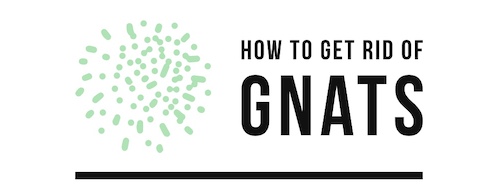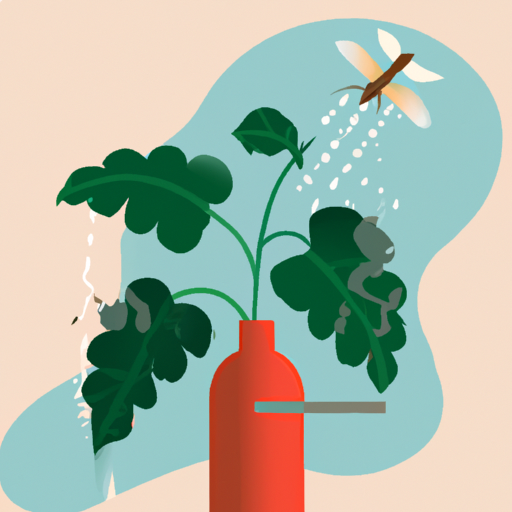How to Use Natural Repellents to Get Rid of Gnats Around Plants
Gnats are small, pesky insects that can be a nuisance around plants. They feed on the sap of plants and can cause damage to the leaves and stems. Fortunately, there are several natural repellents that you can use to get rid of gnats around your plants.
1. Neem Oil: Neem oil is a natural insecticide derived from the neem tree in India. It works by disrupting the reproductive cycle of gnats and other pests, preventing them from laying eggs or maturing into adults. To use neem oil as a repellent, mix 1 teaspoon of neem oil with 1 quart of water in a spray bottle and apply it directly to your plants every few days until the gnat population has been reduced or eliminated.
2. Garlic Spray: Garlic is an effective natural repellent for many types of insects, including gnats. To make garlic spray, blend 4 cloves of garlic with 1 cup of water in a blender until it forms a paste-like consistency then strain out any solids using cheesecloth or another fine mesh strainer before adding it to 2 cups of warm water in a spray bottle and applying it directly to your plants every few days until you see results.
3. Citrus Oil: Citrus oils such as lemon or orange essential oils are also effective at repelling gnats due to their strong scent which masks their food sources like decaying plant matter or fungi found near plant roots where they often congregate for food sources . To use citrus oil as an insect repellent mix 10 drops with 2 cups warm water in a spray bottle then apply directly onto affected areas every few days until you see results .
4. Diatomaceous Earth: Diatomaceous earth is made up tiny fossilized algae particles that act like razor blades when they come into contact with soft-bodied insects like gnats which causes them to dehydrate and die quickly . To use diatomaceous earth as an insecticide simply sprinkle some around affected areas near your plants then reapply after heavy rains or watering .
By using these natural methods you should be able to get rid of any pesky gnat infestations without having to resorting harsh chemical pesticides which could potentially harm beneficial insects like bees or butterflies that may also be present near your garden area .
How to Identify and Treat Plant Diseases Caused by Gnats
Gnats are small, flying insects that can cause a variety of plant diseases. These diseases can be difficult to identify and treat, but with the right knowledge and tools, it is possible to protect your plants from gnat-related damage.
Identifying Gnat-Related Plant Diseases
Gnat-related plant diseases are caused by fungi or bacteria that the gnats spread when they feed on the plants. Symptoms of these diseases vary depending on the type of fungus or bacteria present, but some common signs include wilting leaves, yellowing foliage, stunted growth and discolored spots on leaves or stems. In some cases, you may also notice an increase in gnat activity around your plants.
Treating Gnat-Related Plant Diseases
The first step in treating a gnat-related plant disease is to reduce the number of gnats present in your garden or greenhouse. This can be done by removing any standing water sources near your plants and using insecticides specifically designed for controlling gnats. Once you have reduced the number of gnats present in your garden or greenhouse, you should then focus on treating the underlying disease itself. Depending on what type of fungus or bacteria is causing the problem, this may involve applying fungicides or antibiotics directly to affected areas of your plants as well as providing them with adequate nutrition and light levels for optimal health.
Preventing Future Outbreaks
In addition to treating existing outbreaks of plant disease caused by gnats, it is important to take steps to prevent future outbreaks from occurring as well. This includes regularly inspecting your garden for signs of infestation and taking steps such as removing dead foliage promptly so that new generations of pests do not have a chance to breed there unchecked. Additionally, keeping up with regular maintenance tasks such as pruning back overgrown branches will help ensure that any potential problems are caught early before they become too severe for treatment alone to resolve them effectively.
The Benefits of Introducing Beneficial Insects to Control Gnat Populations Around Plants
Introducing beneficial insects to control gnat populations around plants is an effective and environmentally friendly way to reduce the number of pests in your garden. Beneficial insects, such as ladybugs, lacewings, and parasitic wasps, are natural predators of gnats and other pests. By introducing these beneficial insects into your garden or landscape, you can help reduce the number of gnats that feed on your plants.
Beneficial insects are a great alternative to chemical pesticides because they do not harm beneficial organisms like bees or butterflies. They also do not leave behind any toxic residues that could be harmful to humans or animals. Additionally, they can provide long-term protection against pest infestations since they reproduce quickly and can establish a permanent presence in the area where they were introduced.
In addition to reducing pest populations around plants, introducing beneficial insects also helps promote biodiversity in the environment by providing food for other species such as birds and lizards. This helps create a healthier ecosystem overall by increasing the number of species present in an area which can help maintain balance between predator and prey populations.
Introducing beneficial insects is also cost-effective since it does not require any additional equipment or supplies beyond what is already available at most gardening stores or online retailers. Furthermore, it does not require any special skills or knowledge so anyone with basic gardening experience should be able to successfully introduce these helpful bugs into their garden without too much difficulty.
Overall, introducing beneficial insects into gardens and landscapes is an effective way to reduce gnat populations while promoting biodiversity in the environment without having to resort to chemical pesticides which could potentially harm other organisms living nearby.
Tips for Keeping Your Home and Garden Free from Gnats
1. Keep your home and garden clean. Gnats are attracted to moist, decaying organic matter, so make sure to keep your home and garden free of any rotting food or plant debris.
2. Eliminate standing water sources. Gnats are drawn to standing water, so make sure to empty any containers that may be collecting rainwater or other sources of moisture in your yard or around the house.
3. Use yellow sticky traps for indoor gnat control. Place these traps near windows and other areas where gnats may enter the home in order to capture them before they become a nuisance indoors.
4. Use insecticides outdoors as needed for outdoor gnat control . If you have a large infestation of gnats outdoors, you can use an insecticide labeled for use against them according to the directions on the label in order to reduce their numbers quickly and effectively .
5. Plant certain plants that repel gnats naturally . Certain plants such as marigolds, basil, lavender, rosemary , and citronella can help repel gnats from your garden naturally without having to resort to chemical treatments .
How to Create a Barrier Around Your Plants to Keep Out Gnats
Gnats can be a nuisance in the garden, but there are ways to keep them away from your plants. Creating a barrier around your plants is one of the most effective methods for keeping gnats away. Here’s how to do it:
1. Start by purchasing an insect barrier fabric or netting from your local garden center or online store. This material is designed to keep out small insects like gnats while still allowing air and light to reach your plants.
2. Cut the fabric or netting into pieces that are slightly larger than the area you want to protect, then use stakes or other supports to hold it in place around each plant. Make sure that all edges are securely fastened so that no gaps remain where gnats could enter.
3. If you’re using insect barrier fabric, you may also want to spray it with an insecticide designed for use on outdoor fabrics such as permethrin or bifenthrin every few weeks during peak gnat season (usually late spring and early summer). This will help ensure that any gnats that land on the fabric will be killed before they can get inside and damage your plants.
By following these steps, you should be able to create an effective barrier around your plants that will keep out pesky gnats and other small insects while still allowing air and light through so your plants can thrive!
Q&A
1. What are some natural ways to get rid of gnats around plants?
A: Some natural ways to get rid of gnats around plants include using a mixture of dish soap and water in a spray bottle, placing yellow sticky traps near the plant, and introducing beneficial nematodes into the soil.
2. How can I prevent gnats from coming back?
A: To prevent gnats from coming back, make sure to keep your plants well-watered but not overly saturated, remove any decaying organic matter from the area, and use yellow sticky traps or other insecticides as needed.
3. What is the best way to get rid of fungus gnats?
A: The best way to get rid of fungus gnats is by introducing beneficial nematodes into the soil which will feed on their larvae and eggs. Additionally, you can also use yellow sticky traps or an insecticide specifically designed for fungus gnats if needed.
4. Are there any home remedies that can help with getting rid of gnats around plants?
A: Yes! Home remedies such as using a mixture of dish soap and water in a spray bottle or placing yellow sticky traps near the plant can be effective at getting rid of pesky gnats around your plants without having to resort to chemical insecticides.
5. Is it safe for my pets if I use an insecticide on my plants?
A: It is generally not recommended that you use an insecticide on your plants if you have pets due to potential health risks associated with exposure to these chemicals; however, it is always best practice to read all labels carefully before applying any product in order ensure safety for both yourself and your pets!
Conclusion
In conclusion, getting rid of gnats around plants can be a difficult task. However, by following the steps outlined in this article, you can effectively reduce the number of gnats in your home and garden. Start by removing any standing water or wet soil from around your plants. Then use natural methods such as yellow sticky traps and neem oil to kill off adult gnats and their larvae. Finally, make sure to keep your plants healthy with proper watering and fertilizing practices to prevent future infestations.

